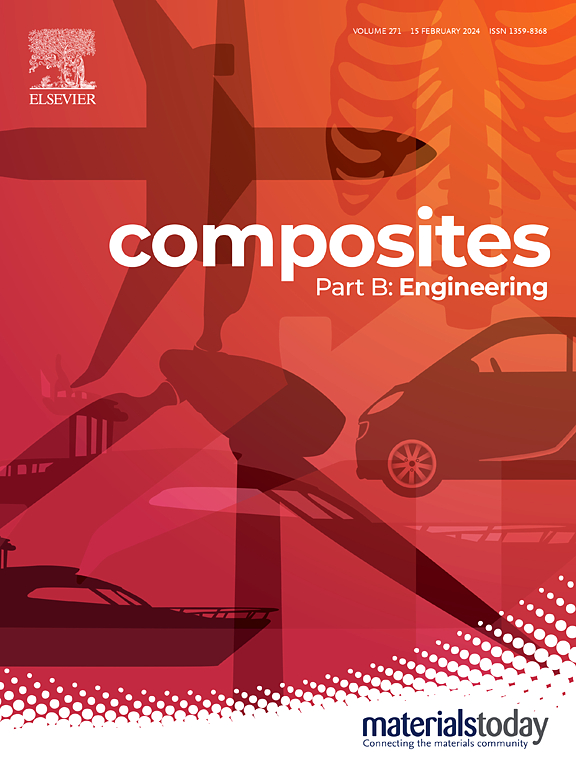The synergistic strength-ductility mechanism of the in-situ constructed interfacial/intragranular hierarchical structure in nano particulate reinforced (TiB+La2O3)/Ti composites
IF 12.7
1区 材料科学
Q1 ENGINEERING, MULTIDISCIPLINARY
引用次数: 0
Abstract
The strength-ductility trade-off has hindered the widespread application of powder metallurgy (PM) titanium matrix composites (TMCs). In-situ planting nano-particles as ultra-fine networks into the TMCs powder and constructing the interfacial/intragranular hierarchical microstructure have emerged as a promising strategy to overcome the strength-ductility trade-off. In the present work, we precisely controlled the distribution of the network nano-particles by adjusting the sintering temperatures and successfully transformed the ultrafine network into the interfacial/intragranular structure. The well-designed (TiB + La2O3)/IMI834 TMCs demonstrated exceptional mechanical properties, achieving a tensile strength of 1158 MPa while maintaining an elongation exceeding 8.6 %—performance comparable to wrought TMCs without requiring thermo-mechanical processing. The dislocation evolution and the slip activation behavior were investigated by in-situ synchrotron X-ray diffraction experiments and interrupted in-situ SEM-EBSD observations, which provided new insights into the strength-ductility synergy mechanism of the interfacial/intragranular nano-particles. These studies revealed that the hierarchical structure enhanced the dislocation storage capacity while simultaneously promoting <c+a> slip activation. This dual effect facilitated multi-system sliding, which effectively optimized dislocation distribution and reduced stress concentration. This study visually elucidates the synergistic strength-ductility mechanism of the interfacial/intragranular hierarchical structure and establishes a straightforward and reliable approach for manufacturing high-performance PM TMCs.
纳米颗粒增强(TiB+La2O3)/Ti复合材料原位构建界面/粒内分层结构的协同强度-延性机制
粉末冶金钛基复合材料的强度-塑性平衡问题阻碍了其广泛应用。在tmc粉末中原位种植纳米颗粒作为超细网络并构建界面/粒内分层微观结构已成为克服强度-延性权衡的一种有希望的策略。在本工作中,我们通过调节烧结温度来精确控制网络纳米粒子的分布,并成功地将超细网络转变为界面/粒内结构。精心设计的(TiB + La2O3)/IMI834 tmc表现出优异的机械性能,抗拉强度达到1158 MPa,伸长率超过8.6%,与锻造tmc性能相当,无需热机械加工。通过原位同步x射线衍射实验和原位中断SEM-EBSD观察,研究了位错演化和滑移激活行为,为界面/粒内纳米颗粒的强度-延性协同机制提供了新的见解。这些研究表明,分层结构增强了位错存储能力,同时促进了<;c+a>;激活。这种双重作用促进了多体系滑动,有效地优化了位错分布,降低了应力集中。本研究直观地阐明了界面/粒内分层结构的强度-延性协同机制,并为制造高性能PM tmc建立了一种简单可靠的方法。
本文章由计算机程序翻译,如有差异,请以英文原文为准。
求助全文
约1分钟内获得全文
求助全文
来源期刊

Composites Part B: Engineering
工程技术-材料科学:复合
CiteScore
24.40
自引率
11.50%
发文量
784
审稿时长
21 days
期刊介绍:
Composites Part B: Engineering is a journal that publishes impactful research of high quality on composite materials. This research is supported by fundamental mechanics and materials science and engineering approaches. The targeted research can cover a wide range of length scales, ranging from nano to micro and meso, and even to the full product and structure level. The journal specifically focuses on engineering applications that involve high performance composites. These applications can range from low volume and high cost to high volume and low cost composite development.
The main goal of the journal is to provide a platform for the prompt publication of original and high quality research. The emphasis is on design, development, modeling, validation, and manufacturing of engineering details and concepts. The journal welcomes both basic research papers and proposals for review articles. Authors are encouraged to address challenges across various application areas. These areas include, but are not limited to, aerospace, automotive, and other surface transportation. The journal also covers energy-related applications, with a focus on renewable energy. Other application areas include infrastructure, off-shore and maritime projects, health care technology, and recreational products.
 求助内容:
求助内容: 应助结果提醒方式:
应助结果提醒方式:


